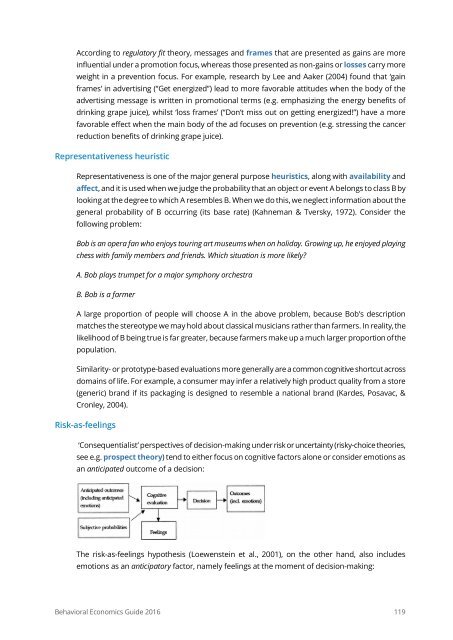THE BEHAVIORAL ECONOMICS GUIDE 2016
BEGuide2016
BEGuide2016
You also want an ePaper? Increase the reach of your titles
YUMPU automatically turns print PDFs into web optimized ePapers that Google loves.
According to regulatory fit theory, messages and frames that are presented as gains are more<br />
influential under a promotion focus, whereas those presented as non-gains or losses carry more<br />
weight in a prevention focus. For example, research by Lee and Aaker (2004) found that ‘gain<br />
frames’ in advertising (“Get energized”) lead to more favorable attitudes when the body of the<br />
advertising message is written in promotional terms (e.g. emphasizing the energy benefits of<br />
drinking grape juice), whilst ‘loss frames’ (“Don’t miss out on getting energized!”) have a more<br />
favorable effect when the main body of the ad focuses on prevention (e.g. stressing the cancer<br />
reduction benefits of drinking grape juice).<br />
Representativeness heuristic<br />
Representativeness is one of the major general purpose heuristics, along with availability and<br />
affect, and it is used when we judge the probability that an object or event A belongs to class B by<br />
looking at the degree to which A resembles B. When we do this, we neglect information about the<br />
general probability of B occurring (its base rate) (Kahneman & Tversky, 1972). Consider the<br />
following problem:<br />
Bob is an opera fan who enjoys touring art museums when on holiday. Growing up, he enjoyed playing<br />
chess with family members and friends. Which situation is more likely?<br />
A. Bob plays trumpet for a major symphony orchestra<br />
B. Bob is a farmer<br />
A large proportion of people will choose A in the above problem, because Bob’s description<br />
matches the stereotype we may hold about classical musicians rather than farmers. In reality, the<br />
likelihood of B being true is far greater, because farmers make up a much larger proportion of the<br />
population.<br />
Similarity- or prototype-based evaluations more generally are a common cognitive shortcut across<br />
domains of life. For example, a consumer may infer a relatively high product quality from a store<br />
(generic) brand if its packaging is designed to resemble a national brand (Kardes, Posavac, &<br />
Cronley, 2004).<br />
Risk-as-feelings<br />
‘Consequentialist’ perspectives of decision-making under risk or uncertainty (risky-choice theories,<br />
see e.g. prospect theory) tend to either focus on cognitive factors alone or consider emotions as<br />
an anticipated outcome of a decision:<br />
The risk-as-feelings hypothesis (Loewenstein et al., 2001), on the other hand, also includes<br />
emotions as an anticipatory factor, namely feelings at the moment of decision-making:<br />
Behavioral Economics Guide <strong>2016</strong> 119


